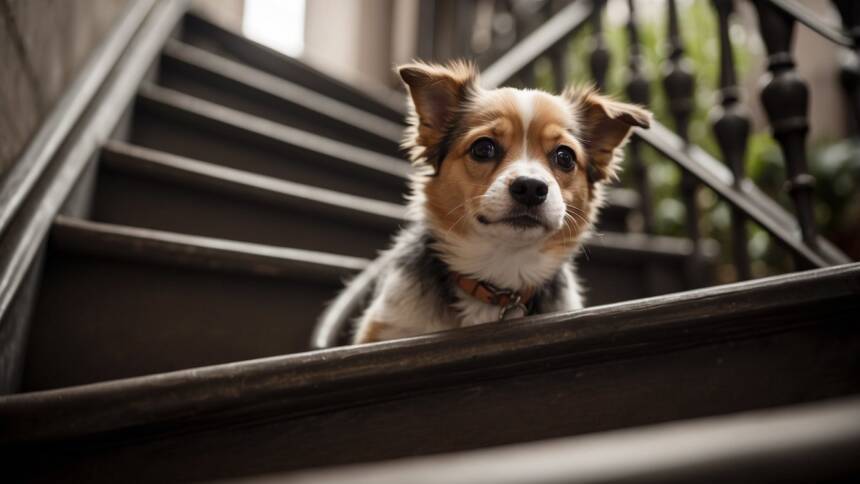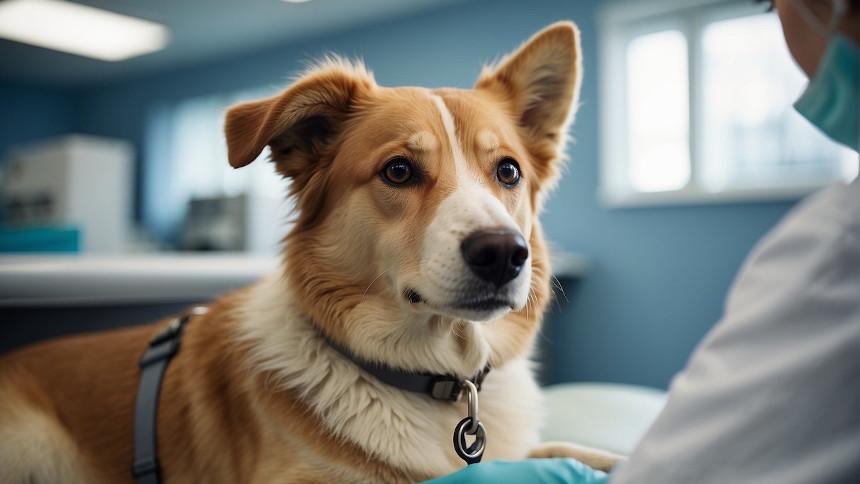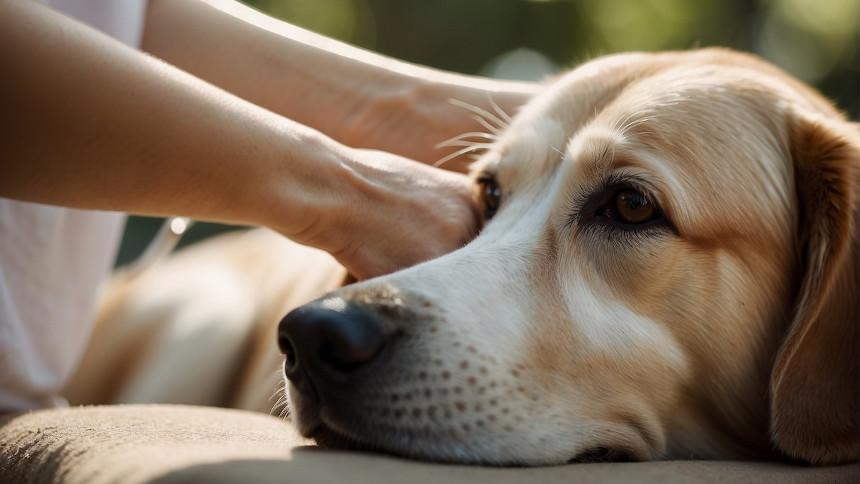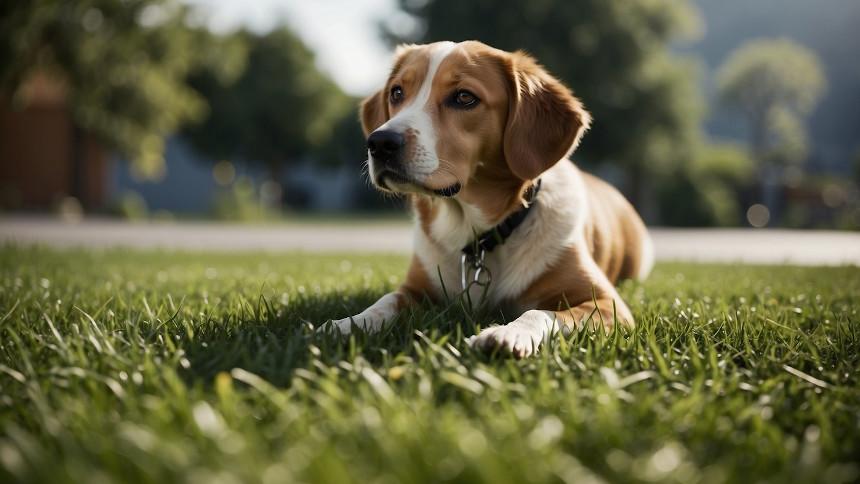Many dog owners have faced the puzzling situation where their four-legged companion is hesitant or outright refuses to navigate stairs. This fear of descending stairs is not uncommon in dogs and can result from various causes, such as a lack of early exposure, negative experiences, or even health issues that make the activity painful or daunting. Understanding the root of a dog’s stair-related anxiety is essential for effective resolution.
Dogs may exhibit reluctance or stress behaviors when approaching stairs, which can include whining, hesitancy, or avoidance. It is crucial for pet owners to recognize these signs of fear and address them promptly. Helping a dog overcome its fear of stairs often involves a combination of positive reinforcement, gradual exposure, and ensuring the dog feels safe and motivated to attempt the task.
When dealing with a dog afraid to descend stairs, patience and positive association are key elements. Providing treats and praise can encourage the dog to face its fears, while removing potential obstacles and ensuring a clear path can prevent additional stressors. In some cases, underlying medical conditions may contribute to the fear, and a check-up from a veterinarian can help rule out or address such health issues.
Understanding Canine Fear of Stairs
Fear of stairs is a common issue among dogs that can be identified by specific signs and triggered by various causes. Understanding this phobia and addressing it effectively requires recognizing these aspects.
Identifying the Signs of Fear in Dogs
Dogs display fear through their body language, such as:
- Tail Position: A tail tucked between the legs is a clear indicator of fear or stress.
- Posture: Reluctance or refusal to approach stairs, or hesitancy and increased tension in the body near staircases.
- Vocalization: Whining, barking, or howling when facing the prospect of ascending or descending stairs.
Recognizing these signs is the first step towards helping a canine overcome their fear of stairs.
Common Causes of Stair Phobia in Canines
Stair phobia in dogs can stem from:
- Lack of exposure: Not being introduced to stairs during the critical socialization period as a puppy.
- Traumatic experience: A previous fall or injury associated with stairs can result in a lasting phobia.
- Physical discomfort: Health issues such as arthritis or vision problems can make navigating stairs painful or difficult, leading to avoidance.
By understanding these causes, owners and trainers can develop appropriate strategies to help their canine companions conquer their fear of stairs.
Assessing Your Dog’s Health and Mobility Issues
When a dog exhibits a sudden fear of stairs, it is essential to consider health and mobility issues that could be affecting its confidence and physical capability. A visit to the vet is often in order to rule out or confirm possible medical conditions.
The Role of Age in Stair Anxiety
As dogs age, they may develop arthritis or other joint issues that make movement painful. Climbing stairs can be particularly challenging for older dogs with hip dysplasia, a common condition that affects the hip joint and reduces mobility. Vision loss, another age-related problem, might cause dogs to become hesitant when faced with stairs, as they can no longer gauge depth and distance effectively.
Medical Conditions Affecting Stair Usage
Aside from age-related concerns, various medical conditions can impact a dog’s ability to maneuver stairs. Even minor pain from a temporary injury can make a dog reluctant to climb or descend. Chronic conditions like arthritis can lead to discomfort and a decreased range of motion, making the act of using stairs seem daunting. A veterinarian can assess for conditions that contribute to stair anxiety, such as:
- Hip and joint issues
- Arthritis
- Vision impairments or vision loss
Early detection and treatment of medical conditions can greatly improve a dog’s quality of life and potentially restore confidence in stair usage.
Practical Training Techniques to Overcome Fear
Training a dog to overcome fear of descending stairs requires patience, confidence-building measures, and consistent positive reinforcement. Employing gentle encouragement and making the process enjoyable are key to successful training.
Introductory Steps to Build Confidence
To help a dog gain confidence, start their training on a flat surface to establish a foundation of trust and command recognition. Once they are comfortable, introduce them to the first step of the stairs. They should be allowed to sniff and explore this new challenge without pressure. Offering treats and praise as they investigate helps reinforce a positive association with the step.
Using Positive Reinforcement Effectively
Positive reinforcement involves rewarding desired behaviors to encourage their repetition. When the dog successfully navigates a step, they should immediately receive a treat and verbal praise such as “good job” to reinforce their action. Consistency in this tactic not only rewards but also builds trust, making each subsequent step a fun and rewarding experience.
Advanced Training Strategies for Desensitization
For desensitization, the goal is to reduce the dog’s fearful reaction to stairs through gradual exposure. Introducing more steps progressively allows the dog to become comfortable at their own pace. A trainer or behaviorist can also use counter-conditioning techniques where the dog learns to associate stair descent with positive outcomes. This element of training should never be rushed; patience is essential to ensure that the dog does not feel overwhelmed.
Environmental Modifications for Dog Safety
When a dog is afraid to navigate stairs, homeowners can implement several environmental modifications to enhance safety and encourage their pet’s confidence. These changes can range from simple tweaks to the stair structure to introducing alternative navigation solutions.
Adjusting the Stairs to Suit Your Dog’s Needs
To address fear of stairs in dogs, it’s crucial to ensure the stairs are as safe and comfortable as possible. One effective modification is to add carpet or stair runners to wood or tile steps to provide traction, which can prevent slipping. A non-slip runner is typically easier for dogs to grip and reassures them as they ascend or descend.
Securing loose and noisy steps is also beneficial. Tightening any wobbly parts can help prevent the stairs from being a source of anxiety. A stable staircase can dramatically improve a dog’s confidence in using them.
Alternative Solutions for Stair Navigation
For dogs who cannot be coaxed to use the stairs or those with mobility issues, alternative solutions may be necessary:
- Ramps: Replace or supplement stairs with a ramp, particularly in cases where the pet is small, elderly, or injured. Ensure the ramp has a non-slip surface and a gentle incline.
- Clutter-Free Paths: Keep the stair area free of clutter. Objects in the way can be additional obstacles for an already nervous dog.
- Use of Blankets: In cases where installing a carpet or runner is not possible, a temporary solution could be to lay down a blanket over the stairs during times of use. This solution can be less stable than a runner, so it should be secured properly to avoid slipping.
By making these environmental modifications, pet owners can help their dogs overcome fear and navigate stairs safely.
The Impact of Breed and Size on Stair Climbing
The capacity of dogs to handle stairs is notably influenced by their breed and size, with each having distinct behavioral tendencies and requiring different strategies to navigate them effectively.
Behavioral Tendencies of Different Breeds Regarding Stairs
Different dog breeds exhibit varying levels of comfort and agility when faced with climbing or descending stairs. Large dogs such as Great Danes and Bernese Mountain Dogs may appear more confident due to their stride length but can be prone to joint issues which may make stair climbing a challenge. On the other hand, small breeds like Dachshunds and Shih Tzus may experience fear or hesitation due to the relative height of each step compared to their size, which can seem like a formidable obstacle.
Meanwhile, breeds known for their agility, such as Border Collies and Australian Shepherds, are generally more adept at navigating stairs due to their athletic build and high levels of confidence. Their innate physical abilities can make them more acclimated to climbing without hesitation.
- Large Breeds
- Can be confident but risk joint issues
- Need to be mindful of the physical impact of stairs
- Small Breeds
- May hesitate due to step height
- Can feel overwhelmed by the size of stairs
Strategies for Small and Large Dogs
Strategies for assisting dogs with stairs must be tailored to the dog’s size. With small dogs, providing a ramp or portable steps can help them gain confidence and protect their joints from the impact of climbing. Teaching small dogs to ascend and descend cautiously will prevent injury and build their confidence over time.
For large dogs, steps should be sufficiently wide to accommodate their size and provide them with secure footing. It may also be beneficial to provide a non-slip surface on the stairs to prevent slips and increase their confidence. Consistent training and positive reinforcement are effective tools for helping large dogs become more comfortable with stair climbing.
- Small Dog Strategies
- Use of ramps or portable steps
- Encourage slow and careful navigation
- Large Dog Strategies
- Wide, non-slip steps for security
- Training for comfort and ease with stair use
Promoting Early Familiarity with Stairs
Training puppies to become comfortable with stairs is pivotal in preventing a lifelong fear of ascending or descending steps.
Importance of Early Exposure for Puppies
Early exposure to stairs is vital for puppies to develop confidence and ease in navigating them. Puppies that do not receive this introduction may develop an aversion or fear, turning what should be a simple task into a stressful situation. Early exposure should be conducted in a manner that prioritizes the safety and comfort of the puppy, with a focus on positive reinforcement.
- Introducing the Stairs: Initially, introduce puppies to a single step to allow them to explore it without the risk of a fall. Encourage them with gentle words and treats for successful interactions.
- Encouragement: Using treats or their favorite toys, guide the puppies up and down that first step, rewarding them for each successful attempt.
- Building on Success: Gradually increase the number of steps the puppy interacts with, always at a pace that keeps them comfortable and confident.
The process should be gradual, reinforcing the puppy’s successful attempts and building a positive association with the activity. Lack of early exposure can lead to a hesitancy that may carry into adulthood, making routine actions like navigating stairs problematic. By methodically increasing the challenge and combining it with encouragement, puppies can overcome apprehension and learn to navigate stairs without fear.
When to Seek Professional Help
When a dog exhibits a fear of descending stairs, it may be indicative of underlying health issues or ingrained behavioral problems. Owners should consider professional assistance when home interventions fail to yield progress.
Consulting a Veterinarian for Underlying Health Issues
It is crucial to rule out medical conditions that could be causing pain or discomfort when the dog is navigating stairs. A trusted veterinarian will conduct a thorough examination to check for:
- Mobility issues: Arthritis or hip dysplasia prevalent in older dogs.
- Vision impairment: Difficulty seeing the stairs can cause fearfulness.
- Neurological conditions: Problems with balance or coordination can hinder stair use.
Seeking veterinary advice is the first step owners should take as soon as they observe a change in their dog’s behavior concerning stairs.
Working with a Behaviorist or Trainer
If the veterinarian finds no medical reason for the fear, owners should consider engaging a certified dog behaviorist or an experienced dog trainer. These professionals understand the nuances of canine behavior and can provide:
- Tailored training programs: Customized approaches that cater to the dog’s specific needs.
- Desensitization techniques: Gradual exposure to stairs combined with positive reinforcement.
- Trust-building exercises: Strengthening the bond between the owner and the dog to increase confidence.
Owners must ensure that the professionals they work with are trustworthy and have a proven track record of dealing with similar behavioral issues.
Creating a Supportive Environment for Your Canine Companion
Creating a supportive environment involves establishing trust and security at home and ensuring consistency in routine. These foundations help a canine companion feel safe to take on the challenge, such as navigating a flight of stairs, with less fear.
Developing Trust and Security in Your Home
To build a sense of trust and security, owners should ensure their home is a safe haven for their dog. Here are specific steps to help dogs overcome fear of stairs:
- Remove Clutter: Keep the stair area free of toys or loose items that could startle or trip the dog.
- Add Traction: Place non-slip mats or carpet on the stairs to prevent slipping and to provide secure footing.
- Introduce a Toy: Use a favorite toy to draw their interest and create positive associations with the stairs.
- Encouragement: Gently coax with a calm and soothing voice to provide comfort and assurance to a hesitant dog.
Maintaining Consistency and Routine
Consistent actions and routines foster confidence in dogs. To help a dog overcome the fear of stairs, implement a regular training schedule:
- Daily Practice: Schedule short, daily sessions to practice using the stairs.
- Step-by-Step Approach: Begin by training to use one step at a time and gradually increase the challenge as the dog becomes more confident.
- Rewards: Utilize treats or verbal praise to reward the dog’s progress, reinforcing positive behavior.
- No Pressure: Avoid forcing the dog to use the stairs, as this can reinforce fear. Instead, allow them to approach this challenge at their own pace.








